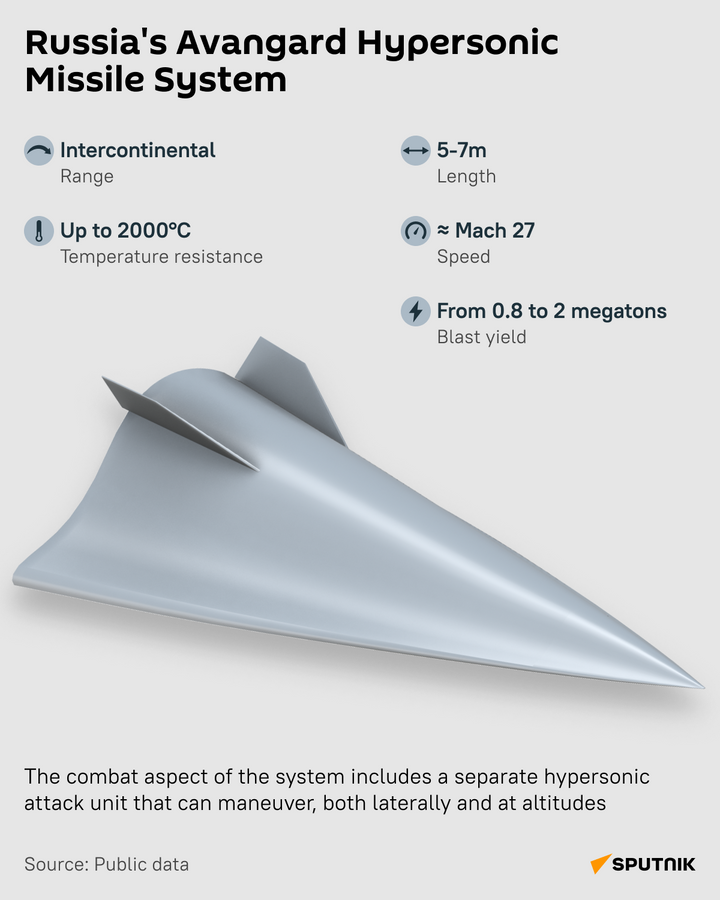Avangards can accelerate to speeds of up to Mach 27 (32,200 km) in near-space conditions, dropping to an estimated Mach 15-20 (18,500-23,000 km) by atmospheric drag during descent.
In an interview with Russian media on Wednesday, the Russian president assured that Russia’s nuclear triad is “more modern” than that of any other country, and reiterated that Moscow would never use such fearsome arms unless its statehood is threatened.
Russia’s nuclear-capable Avangard hypersonic glide vehicles have rendered massive US investments into the creation of a missile defense system useless, Vladimir Putin has announced.
Watch the full video of President Putin’s interview with Rossiya Segodnya Director General Dmitry Kiselev here.
“If you calculate how much [the US’] well-known missile defenses cost them, one of the main components for overcoming these missile defenses that we have is the Avangard, an intercontinental missile with an intercontinental-range glide unit. So you cannot compare budgets. We’ve basically nullified everything they’ve done, everything they’ve invested in this missile defense system,” Putin told Dmitry Kiselev, director of Sputnik parent media group Rossiaya Segodnya, remarking on the immense largesse and waste in the US defense industry.
The experience of the developing the Avangard demonstrates the course Russia should continue to stick to in the field of strategic armaments, Putin said.
What is the Avangard?
First unveiled by Putin in a speech to Russian lawmakers in 2018 and introduced into service in late 2019, the Avangard (lit. “Vanguard”) is a maneuverable, blazing fast, nuclear-capable hypersonic glide vehicle designed to penetrate all existing and future missile defense systems.
Boosted into orbit on board R-36 and RS-28 Sarmat heavy intercontinental ballistic missiles and deployed as part of the missiles’ multiple reentry vehicle (MIRV) payloads, Avangards can accelerate to speeds of up to Mach 27 (32,200 km) in near-space conditions, dropping to an estimated Mach 15-20 (18,500-23,000 km) by atmospheric drag during descent.
The glide vehicles have a reported independent range of more than 6,000 km, and an explosive power of between 0.8 and two megatons. They’re also available in conventional mode, using the immense kinetic force generated by the high speed at which they hit their targets to destroy an array of strategic objectives.

Along with maneuverability and speed, the characteristics of their flight, and specifically the weapons’ ability to withstand temperatures of up to 2,000 degrees Celsius are another factor making defense against the Avangard essentially impossible.
“The Avangard is practically covered with plasma [during flight, ed.] and the plasma absorbs electromagnetic rays, thus making the hypersonic vehicle invisible to radar. As a result of high kinetic energy, the Avangard can destroy targets without the use of nuclear weapons. This is a unique tool, and to date no other country in the world has created anything like it,” military historian, defense commentator, and missile and air defense specialist Yuri Knutov recently told Sputnik.
With their carrier rockets having a flight range between 15,200 and 18,000 km, the Avangard can strike any point on Earth.Up to two dozen Avangards can be packed into a single Sarmat missile, with the rocket also capable of carrying other MIRVs, as well as dummy warheads designed to fool and disperse enemy missile defenses.
The Avangard is one of half-a-dozen new strategic-class weapons in Russia’s arsenal, with these armaments designed to ensure that even if an adversary were to manage to catch Russia off-guard in a nuclear or conventional first strike, the guaranteed response would nevertheless be severe enough to force enemy planners to think twice before launching aggression.
Russia’s NPO Mashinostroyenia rocket design bureau led the development of the Avangard. Lauding legendary Honorary General Director and designer Gerbert Efremov on his birthday in 2020, Putin comparedMashinostroyenia’s success in creating the Avangard with the USSR’s creation of its first nuclear bomb in 1949.
Under Efremov’s leadership, NPO Mashinostroyenia created the predecessor to the Avangard program in the 1980s, with the top secret project, known as “Project 4202” and later codenamed “Albatross,” approved for development in 1987 as a direct response to Ronald Reagan’s “Star Wars” missile defense concept. The project was put on hold in the early 1990s due to then warming relations with Washington, and later, due to financial difficulties associated with the collapse of the Soviet Union.
Russia resumed work on its unique anti-missile defense projects in the early 2000s, after the US unilaterally walked out of the Anti-Ballistic Missile Treaty and began to deploy a missile defense shield in Europe.
“America’s withdrawal from the ABM Treaty in 2002 forced Russia to start developing hypersonic weapons,” Putin recalled in his conversation with Efremov. “We had to create these weapons in response to the deployment of the US strategic missile defense system, which would have been able to neutralize and render obsolete our entire nuclear potential […] For the first time in modern Russia’s history, the country possesses the most modern types of weapons, which are far superior in terms of their force, power, speed and, very importantly, in terms of accuracy compared to all which existed before them and exist today,” Putin said.
BREAKING: Fox News Reports COVID-19 Shots Contain Toxic DNA and Cancer Viruses